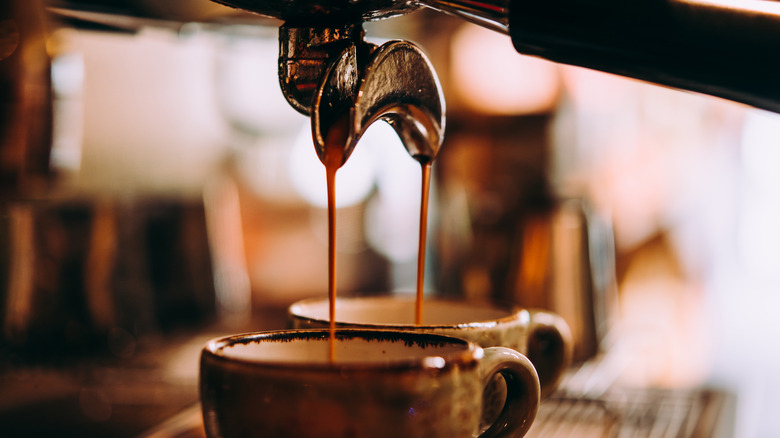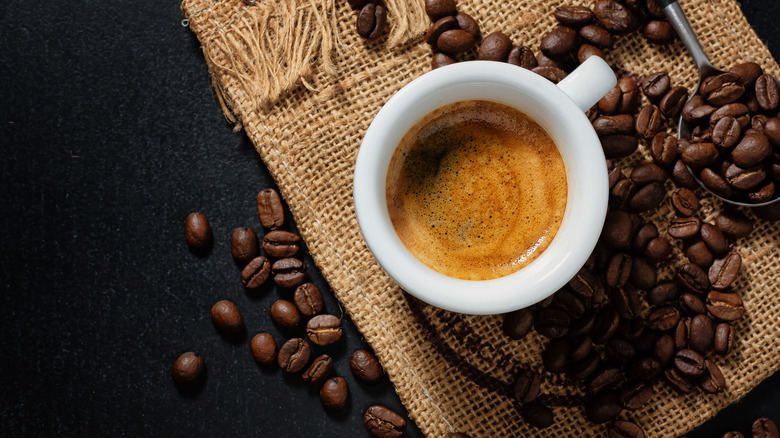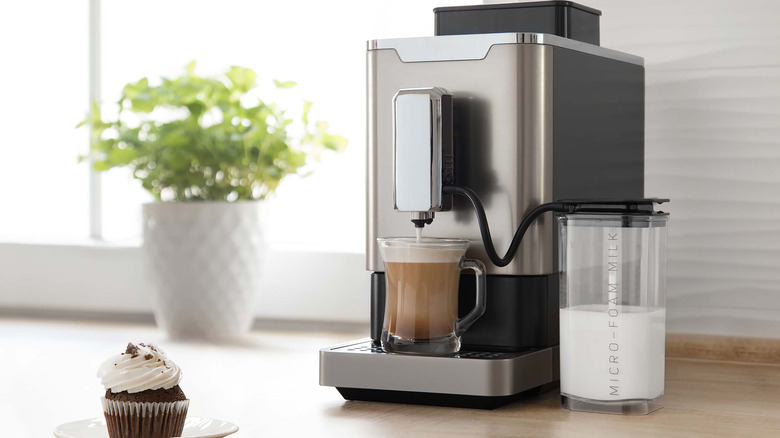Mistakes You're Making With Your Espresso Machine
Whether you drink espresso on its own or mixed into lattes, there's nothing more satisfying than making your own espresso at home. All one needs is an espresso machine and some beans before they can have handcrafted beverages at the ready. Still, there are some pitfalls one can fall into if they've never used an espresso machine before.
Espresso typically comes in a tiny cup and is pulled from an espresso machine in shots (via Perfect Daily Grind). Therefore, if you want to make a latte or other espresso-based beverage stronger, an extra shot or two is the way to go. When working with an espresso machine, one needs to know its essential components and processes. According to Perfect Daily Grind, an espresso machine requires you to measure out espresso grounds and tamp — firmly pack — them into a portafilter. The portafilter then gets secured into the machine, and hot water soaks through the espresso grounds, dripping rich espresso down into your tiny cup. From here, you can mix the espresso into a drink or enjoy it black.
While the process sounds relatively simple, espresso is a complex bean, and its machines are complex, too.
Grinding fresh espresso beans is always best
Everybody reacts differently to drinking espresso every day, but for many, it's a staple part of their morning routines. As such, it's important to know how to properly work your espresso machine for optimal flavor and to ensure the machine stays in good condition. In fact, one of the easiest mistakes that can be observed is whether your espresso shots are pulling correctly. According to The Coffee Brewers, every shot of espresso should have a layer of crema on top, which looks light in color and foamy. If you don't have crema, you can try using fresher grounds, tamping the grounds better, or adjusting your coffee grinder.
Moreover, a big mistake is using pre-ground coffee for espresso (via North Star Roast). Coffee oils lose their flavor and potency as they sit, so best results will always come from fresh grounds. This is why you should try fresher grounds if you're not getting a layer of crema on top of your espresso.
Similarly, when grinding beans at home, ensure you're using the right grinding setting. North Star Roast explains that espresso needs to be ground in a perfect medium, between coarse and fine, though finer is typically better than coarser. How coarse or fine they are determines how long the shots take to pull, which affects their flavor. A good pull time is 25 to 30 seconds, so don't be afraid to time your shots to find the best setting on your grinder. Professional baristas time their shots!
Tamping unevenly can completely change an espresso shot's flavor profile
Ultimately, one of the biggest mistakes one can make in the espresso world is purchasing the wrong equipment. Espresso machines on the market range from very affordable to unbelievably expensive, but finding one in the middle will yield the best results (via The Kitchn). Buying a cheap espresso machine may lead to disappointment as it won't provide the same quality of espresso shots and may even break down sooner than pricier ones.
No matter which espresso machine you buy, your tamping needs to be even. According to Choice, uneven tamping pressure leads to poor espresso shots. This simply means that your grounds should be in an even, compact layer once you've tamped them in. This will lead to the most well-rounded flavor and a good crema.
At the same time, Choice notes that you can't forget to clean your machine. It's easy for espresso grounds to clog up your machine, nonetheless the myriad ways all other kitchen equipment get dirty. Maintaining overall cleanliness will not only make your drinks taste better but also keep your machine running longer.
Finally, don't forget to heat up your machine properly before you use it, and always flush out some water in the locked-in portafilter before pulling a shot. Per Choice, this all "warms up" the machine and helps it deliver the best result.
Happy drinking!


